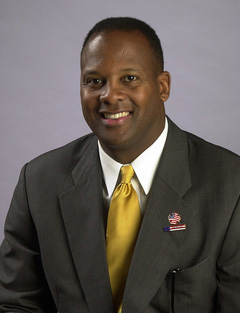The Statement: from ACTS Mayoral Forum
From: Otis Jennings, Conservative Party
Type: Response to a question at a candidate forum
Date: Sept. 9, 2009, Hopps Memorial Church in Syracuse
SUMMARY: Jennings is responding to a question for the mayoral candidates to name two specific programs or actions they would take to “move our city towards racial equity.” At the time, Jennings was running for the Republican nomination. In the Sept. 15 primary, Jennings lost the GOP nomination to TV executive Steve Kimatian. Jennings continues to run as the Conservative Party candidate. Stephanie Miner is the Democratic candidate for mayor. The election is Nov. 3. In his answer, Jennings painted an imprecise picture of after-school programs in Syracuse, but his views reflect a widespread consensus on the need for such programs.
What He Says:
“There’s 5,000 middle school students. Only a small percentage of them have afterschool programming.… We need to make sure they are engaged in comprehensive programming. Three and eight (p.m.) is the most critical hours — they are the most critical hours of our school day and that’s where the gangs do a better job at mentoring our children than we do.”
The Facts:
1. “There are 5,000 middle school students. Only a small percentage of them have after-school programming.”
The statement is imprecise but illustrates a general concern for school-age children.
More than half of the district’s 4,049 middle school students are involved in after-school programs, both public and private, according to numbers provided by Mary Torak, a program supervisor for the city’s board of education.
In an interview, Jennings said that no matter what the number, he would focus on at-risk children. “I’m talking about those who really need the help,” he said. “Now, what is that percentage? I’m not sure,” he said. “I know there are parents in the Syracuse City School District that, between 3 and 8 (p.m.) there are some moms at home, some dads at home. And there are some that are in structured programs, who are in the Syracuse Boys and Girls Club, through Parks and Recreation, Catholic Charities. But I know, too, there’s a large percentage — don’t ask me for a number — a large percentage that’s not connected.”
To get the kids connected to supportive after-school programs, Jennings pledged to work to get the schools connected with private and public organizations. “It will be through a number of government and social service agencies throughout the city, ” Jennings said in an interview. “I would encourage any agency to get involved. You could have a special clearing house. A number of programs offer tutoring. A number offer educational initiatives. We just need to put them together so we are all doing the same thing.”
2. [Three p.m. to 8 p.m.] “are the most critical hours of our school day… We need to focus that three to eight hour with comprehensive programming to help our young children stay connected.”
Mostly accurate. Education experts say that after-school programs are helpful ways to lower crime rates and improve academic performance. But anecdotal evidence shows and experts say that after-school programs, while never harmful, are not a magic potion.
“I would say that thinking that after-school programs can be the cure-all can be unrealistic,” said Jen Rinehart, the vice president of policy and research for the nonprofit advocacy organization Afterschool Alliance, a national organization based in Washington, D.C. “Obviously the impact of programs is limited up to three hours a day. The school day is twice that. They clearly can contribute to school achievement, but they’re not the only factor.”
Tiffany A. Koszalka is a professor of instructional design, development and evaluation at Syracuse University. After-school programs, she said, help reduce crime rates and improve academic performance. The variety of choices offered to students is what helps improve academic achievement and lower crime rates, Koszalka said.
Activities can include athletics, dance, music, reading, math, and science. “All of those things are good for kids because it expands their mind and it keeps them from getting into trouble,” she said.
3. “…and that’s where the gangs do a better job at mentoring our children than we do.”
Accurate. Jennings is implying—confirmed in an interview with Democracywise—that crime rates are higher in the hours directly after school. Experts and statistics agree.
More than 12 percent of violent juvenile crimes are committed at 3 p.m., higher than any other time, according to FBI figures. That’s compared with a 5-percent share for 9 p.m. At midnight the percentage drops to 2 percent.
A report by Fight Crime: Invest in Kids, a nonprofit advocacy organization of law enforcement officials based in Washington, D.C., concludes: “On school days, the prime time for juvenile crime is 3 p.m. to 6 p.m.”
The solution is after-school programming, the organization says. “Quality after-school programs can cut crime and violence immediately and transform the prime time for juvenile crime into golden hours of academic enrichment, wholesome fun and community service,” the report says. The report cites program called Quantum in 26 cities. Boys participating in the Quantum program were one-sixth as likely to be convicted of a violent crime in high school than those that did not participate in the program.
A study by the University of California at Los Angeles found that kids who went through the LA’s BEST program were less likely to commit crimes. And more time in the program had an even stronger effect, the study found. Students who spent one year in the LA’s BEST program committed 112 felonies. Those who spent four years in the program committed 17.
The UCLA report concludes: “Results indicate that after-school programs are potentially a powerful resource that can help reduce juvenile delinquency rates.”
Conclusion:
Jennings’ statement is largely accurate. Many students in the Syracuse area have after-school programs. But education experts say that Jennings is right to call for more.
(Brian Amaral a senior majoring in newspaper journalism.)
-30-



